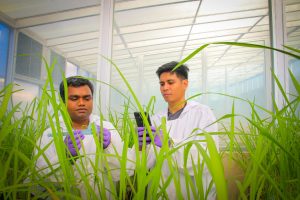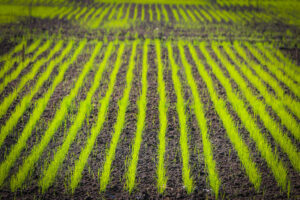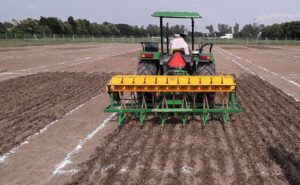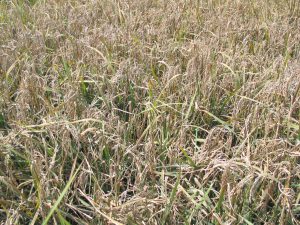Rice is the staple food for around two-thirds of the Chinese people. China ranks first in annual total rice production (about 185 million tons) and second, after India, in annual total planting area (29 million hectares). The country produces 35% of the world’s rice with 20% of the planting area.
Rice production in China has more than tripled in the past five decades mainly due to increased grain yield rather than increased planting area. This increase has come from the development of high-yielding varieties (including hybrid varieties) and improved crop management practices such as nitrogen fertilization and irrigation. The national average rice yield is about 6.25 tons per hectare compared with the world average of 3.75 tons per hectare.
As its population rises, China will need to produce about 20% more rice by 2030 to meet domestic needs if rice consumption per capita stays at the current level. This is not easy—several trends and problems in the Chinese rice production system constrain a sustainable increase in total rice production. These include a decline in arable land, increasing water scarcity, climate change, labor shortages, and increasing consumer demand for highquality rice (often from low-yielding varieties).
The major problems confronting rice production in China are as follows:
Narrow genetic background. Low genetic diversity in commercially grown rice cultivars has led to vulnerability to biotic stresses (pests and diseases) and abiotic stresses (such as drought and salinity). The situation is particularly troublesome in China because 50% of the rice-planting area is occupied by hybrid rice, which is developed using only a few varieties as the female parent.
Overfertilization. In 2002, the average rate of nitrogen (N) fertilizer application for rice production in China was 180 kilograms per hectare, about 75% higher than the world average. Only 20–30% of this N is taken up by the rice plant, with a large proportion lost to the environment. In some cases, overapplication of N fertilizer may actually decrease grain yield by increasing the plant’s susceptibility to lodging (falling over) and damage from pests and diseases.
Overuse of pesticides. On average, Chinese rice farmers—who tend to grossly overestimate crop losses caused by pests—are overusing pesticides by more than 40%. In many cases, overuse of pesticides actually contributes to pest outbreaks because it reduces the biodiversity of rice ecosystems, killing natural predators of pests as well as the pests themselves.
Breakdown of irrigation infrastructure. China’s irrigation infrastructure was established mainly in the 1970s. Since then, maintenance of existing irrigation systems and building of new facilities have been very limited. Coupled with declining freshwater resources, this problem may greatly reduce the area planted to flood-irrigated rice in China.
Oversimplified crop management. Because of labor migration and increases in labor wages, decreased labor input for rice production has resulted in compromised crop management that may contribute to reduced yields.
Weak extension system. Because of insufficient financial support, many extension workers earn part of their salary by selling agrochemicals to farmers, which may promote overuse of fertilizers and pesticides. Furthermore, the weakness of the system means that improved technologies may not reach farmers.
Despite the challenges, good research strategies can drive increased rice product ion in China. These include:
Increasing yield potential. China has been at the forefront in attempting to develop high-yielding semidwarf, hybrid, and new plant type varieties. Further progress in increasing rice yield potential is possible when new breeding techniques, such as marker-aided selection and genetic engineering, are combined with conventional breeding.
Drought and heat tolerance. Drought and heat stress are increasingly important constraints to rice production in China, mostly due to variation in rainfall patterns from year to year, uneven distribution of rainfall in the rice growing season, and higher temperatures resulting from climate change. Chinese scientists have identified and mapped genes for drought and heat tolerance, and are developing new varieties.
Disease and insect resistance. Huge yield losses occur because of biotic stresses every year. Chinese scientists have isolated and cloned from cultivated and wild rice species many genes that contribute to disease and insect resistance, and have transferred these into local varieties.
Integrated crop management. New crop management technologies need to be developed using whole-system approaches. Synergy among fertilizer, water, and pest management can maximize the overall efficiency of the production system. Sustainability of the rice production system can be maintained only when the natural resource base is protected and the health of the rice ecosystem is maximized.
_________________________________________
Dr. Peng is a senior crop physiologist at IRRI.










